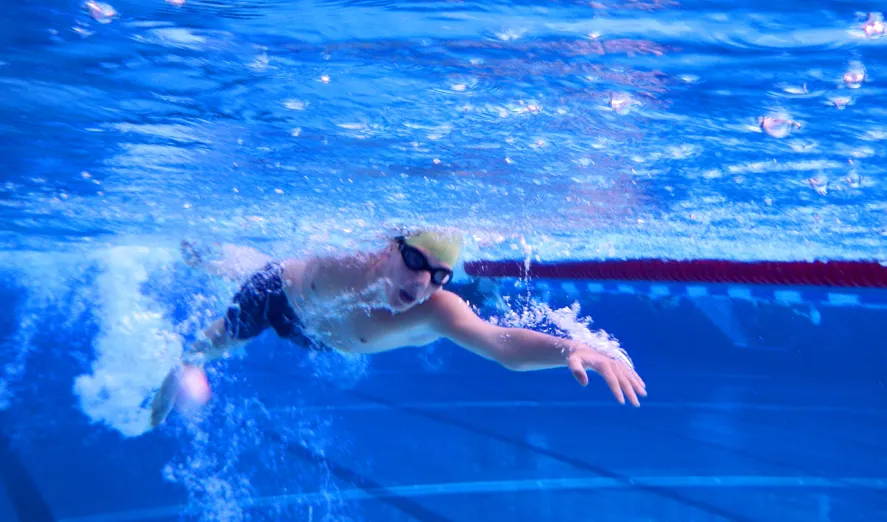Schwimmen - für einige Triathleten die größte Problemdisziplin. Der Grund hierfür ist aber häufig nur eine mangelnde Vorbereitung und schlecht angepasste Trainingspläne, und damit durchaus ein behebbares Problem. Um sich ideal für den nassen Beginn des Triathlons vorzubereiten, reicht es nämlich nicht, einfach die Zeit im Wasser so lange wie möglich zu gestalten. Dies führt nämlich nur zu oft zu planschenden Dauerschwimmen und damit nicht zu einer verbesserung der Performance im Wasser.
Die häufigsten Fehler beim Schwimmtraining und Tipps, wie ihr ebendiese vermeidet, zeigen wir euch hier.
1. Kein Training oder wenig effektives Training
Damit die Leistung im Wasser möglichst hoch und der Energieverbrauch möglichst gering ist, benötigt man eine effektive Technik. Besonders bei Triathleten ist die Verbesserung der Kondition meist nicht mehr gebraucht, da die Ausdauer bereits ausreichend beim Lauf- und Radtraining gefordert und aufgebaut wird. Daher ist beim Schwimmen der Fokus auf die korrekte Technik umso wichtiger, weswegen der erste Teil des Triathlons auch eine andere Herangehensweise erfordert, als die übrigen beiden Disziplinen.
Das Techniktraining sollte deswegen in keiner Trainingseinheit fehlen, da die meisten Triathleten nicht vom Schwimmen kommen und daher ein ineffizienter Schwimmstil sehr häufig ein Problem darstellt. Vor diesem Hintergrund haben viele Athleten trotzdem nicht genug Technik-Einheiten in ihrem Trainingsplan implementiert, oder Technik-Übungen werden einfach nur heruntergespult, ohne sich auf den wirklichen Kern der Übung zu Konzentrieren, oder auf das Feedback des Körpers zu achten.
Tipp: Versuche dein Schwimmtempo im Training nicht zu hoch anzulegen, damit du dich wirklich auf jeden einzelnen Bewegungsablauf konzentrieren kannst! Außerdem ist es hilfreich, sich bei jeder Technik-Einheit auf einen Bereich zu konzentrieren, beispielsweise den häufig auftretenden "hohen Kopf" oder die verspätete Atmung. Auch ein Schwimmseminar für Triathleten ist durchaus eine sinnvolle Investition, da dort die richtige Technik von Anfang an en detail vermittelt wird.
2. Mangelnde Abwechslung
Der häufigste Ansatz beim Schwimmtraining ist das Dauerschwimmen. Dabei hält man sich einfach so lange wie möglich im Wasser auf und schwimmt die ganze Zeit seine Bahnen. Bei dieser Trainingsart werden zwar vielleicht ein paar Kalorien verbrannt, jedoch trägt sie nicht zu einer Verbesserung des Schwimm-Tempos bei.
Trainingseinheiten sollten daher lieber in Intervallen aufgebaut werden: Das bedeutet, nicht jedes Mal 1.000m am Stück zu schwimmen, sondern die Trainingseinheit in Abschnitte zu unterteilen, welche zwischen 25 und 400 Meter lang sein können. Aufgrund der Kürze dieser Distanzen ist es deutlich besser möglich, eine effiziente Technik aufrecht zu erhalten und in einem höheren Tempo zu schwimmen. Bei der Geschwindigkeit kann man sich dabei an die angestrebten Wettkampfszeiten halten, zum Beispiel 10 x 100 Meter in 1:45 Minuten.
Tipp: Starte zu Beginn des Trainingsjahres mit kürzeren Intervallen (25-50m) und schwimme diese im Sprint, um dadurch deine Grundschnelligkeit zu verbessern. Steiger diese Intervalle dann mit der Zeit. Außerdem ist es wichtig, auf eine Abwechslung der Einheiten zu achten und auch mal langsame, technikorientierte Intervalle einzubauen.
3. Kein ergänzendes Stabi- / Beweglichkeitstraining
Bei vielen Triathleten wird die Beweglichkeit und die Rumpfstabilität vernachlässigt. Jedoch hat sich gezeigt, dass in diesen Bereichen, gezieltes Training zu deutlicher Leistungsverbesserung führen kann.
Beim Schwimmen ist besonders die Lage im Wasser von hoher Wichtigkeit. Um eine möglichst effiziente Wasserlage zu erreichen, benötigt man eine gute Rumpfmuskulatur.
Zusätzlich werden Rücken und Bauch beansprucht um die Arm- und Beinschläge auszugleichen. Trainiert man also die Stabilität und die Rumpfmuskulatur, kann man die Wasserlage enorm verbessern. Auch die Beweglichkeit wird gefordert, da bei einem effektiven Armzug, die Rotation der Schulter und die Streckung des Arms sehr wichtig sind. Auch das Verletzungsrisiko kann durch regelmäßiges Beweglichkeitstraining deutlich reduziert werden.
Tipp: Implementiere mindestens zweimal pro Woche für je 30 Minuten Rumpfstabilisationsübungen und schwimmspezifische Dehnübungen in deinen Trainingsplan.
4. Verlassen auf Schwimmhilfen
Viele Triathleten trainieren so, als wären Paddels und Pull-Buoys ihre besten Freunde. Aber ist das die richtige Einstellung? Durch Pull-Buoys kann man leicht eine schlechte Wasserlage korrigieren und trotz ineffizienter Beinarbeit schneller schwimmen. Man betrügt sich also selbst und bekommt das Gefühl eine gute Technik zu besitzen. Ein ähnliches Problem tritt auch bei den Paddels auf: Die Antriebsfläche ist größer, und man wird dadurch schneller, allerdings verbessert es nicht die Armzugtechnik und die erhöhte Kraftbelastung kann zu einer Sehnenreizung im Schulterbereich kommen.
Wenn man die Schwimmhilfen dann wieder auszieht, wo bei den Wettkämpfen ja kein Weg dran vorbei führt, ist der Körper die wirkliche Belastung, ohne Unterstützung der Utensilien nicht mehr gewöhnt, worunter die Technik dann leiden muss. Schwimmhilfen sollten also nicht zu oft und wenn dann nur gezielt im Training verwendet werden, beispielsweise um sich besonders auf einen speziellen Bereich der Technik zu konzentrieren.
Tipp: Wie auch beim Aufbau des Trainings gilt, Abwechslung ist wichtig! Nutze Pull-Buoys, Paddels und Flossen im Training, behalte aber im Kopf, dass du diese im Wettkampf nicht verwenden darfst. Eine Möglichkeit wäre beispielsweise Intervalle mit Fokus auf Beinschlag und Armzug mit Schwimmhilfen zu schwimmen und die gleichen Intervalle dann wieder im Freistil, um so deine Wasserlage zu verbesern und das Gefühl für das Schwimmen mit und ohne Hilfen zu verstärken.
5. Kein Training im Freiwasser
Bei den meisten Triathlon-Wettkämpfen findet die Schwimm-Disziplin in einem offenen Gewässer statt, was die Schwimmleistung sehr stark beeinflussen kann. Neben Kälte, Wellen und Orientierungsschwierigkeiten hat man zusätzlich noch mit dem bisher ungewohnten Körperkontakt mit anderen Athleten zu kämpfen.
Passt man sein Training diesen Umständen nicht an, ist es nur schwer möglich die Leistung im Becken dann auch im Wettkampf zu zeigen. Eine weitere Umstellung kann der Neoprenanzug darstellen, da dieser die Schwimmtechnik beeinflusst. Zwar wird die Wasserlage durch den erhöhten Auftrieb verbessert, allerdings wird gleichzeitig die Bewegungsfreiheit der Arme und Schultern eingeschränkt. Dadurch macht der Neoprenanzug zwar schlechtere Schwimmer etwas schneller, aber man sollte die Muskulatur trotzdem im Training auf die veränderte Technik einstellen.
Tipp: Sofort wenn es das Wetter zulässt, sind Schwimmeinheiten im Freiwasser einmal wöchentlich zu empfehlen. Hol dir dazu am besten noch deinen Trainingspartner dazu um so den Körperkontakt und das Schwimmen im Wasserschatten zu simulieren.
Das wichtigste Schwimmzubehör für den Beckenrand
Verschiedene Trainingsmittel können für gezieltes Techniktraining, aber auch zum weiterführenden Kraft- und Ausdauertraining eingesetzt werden.




















